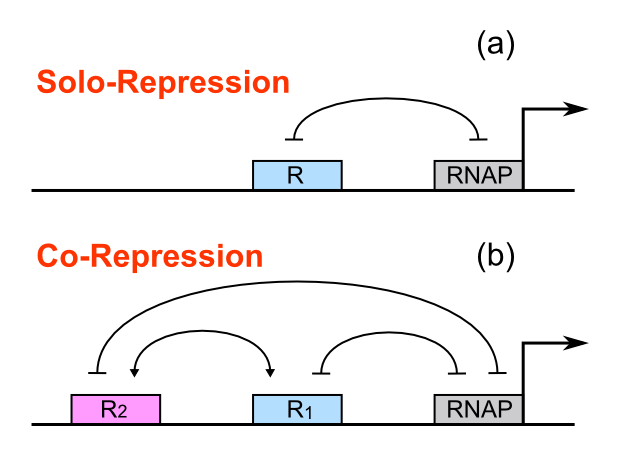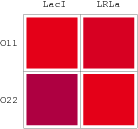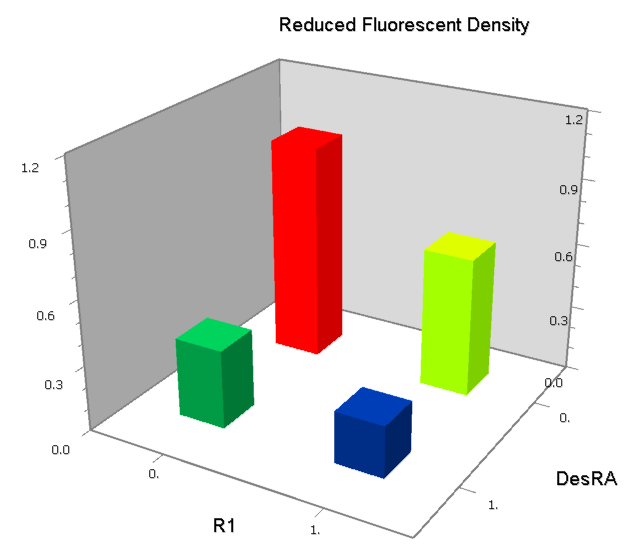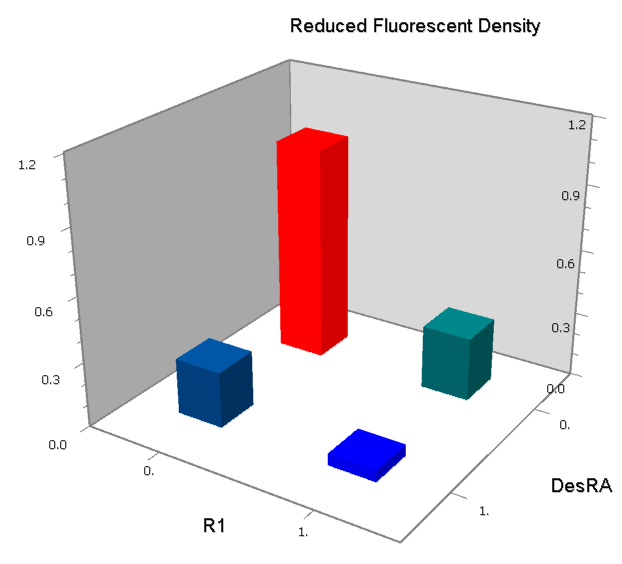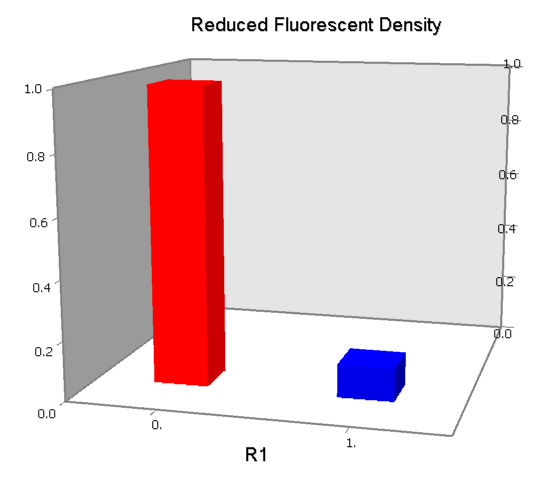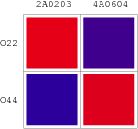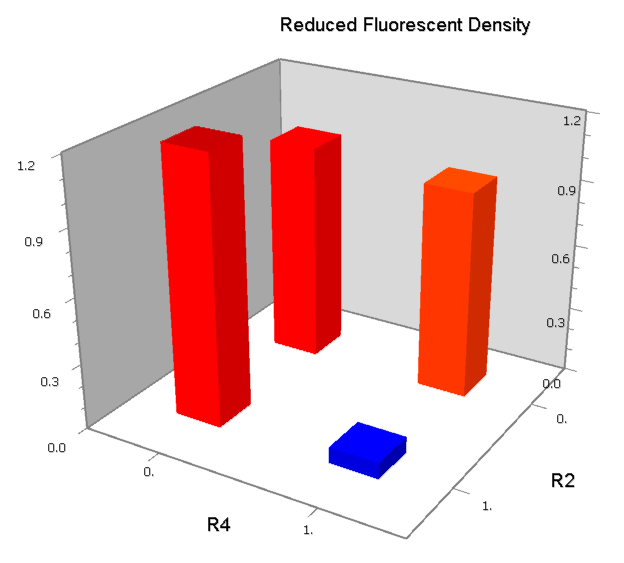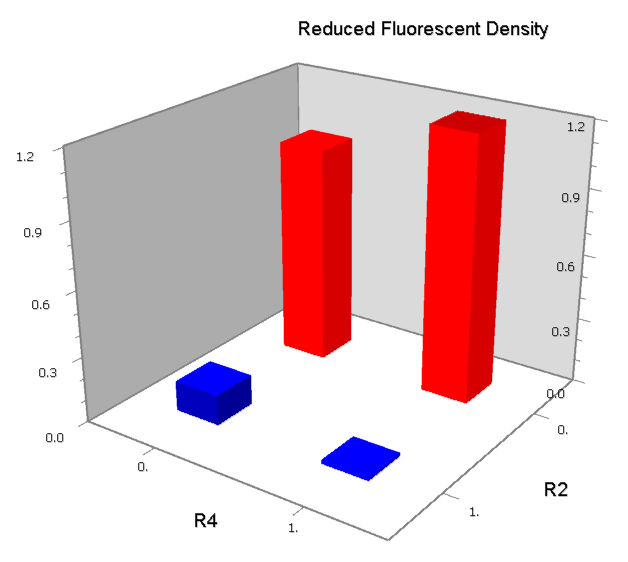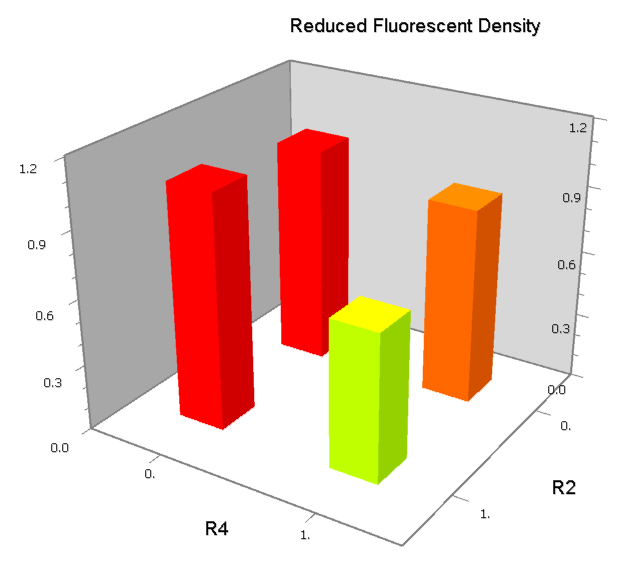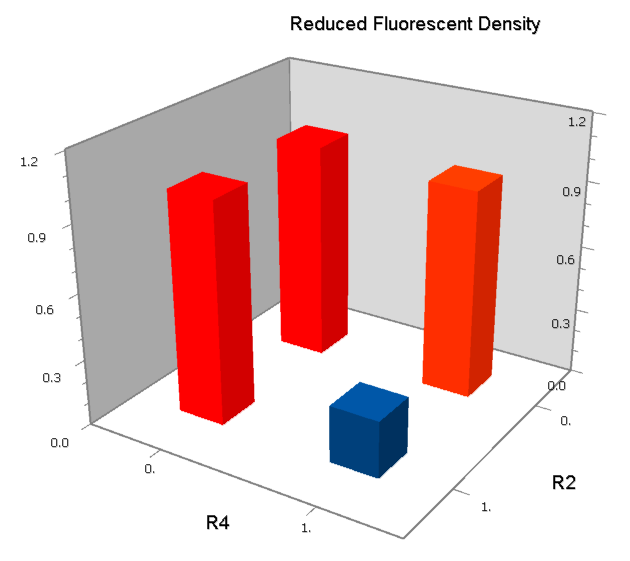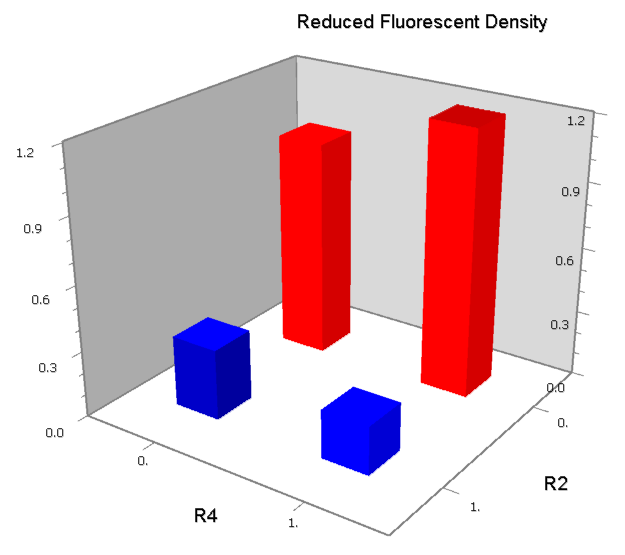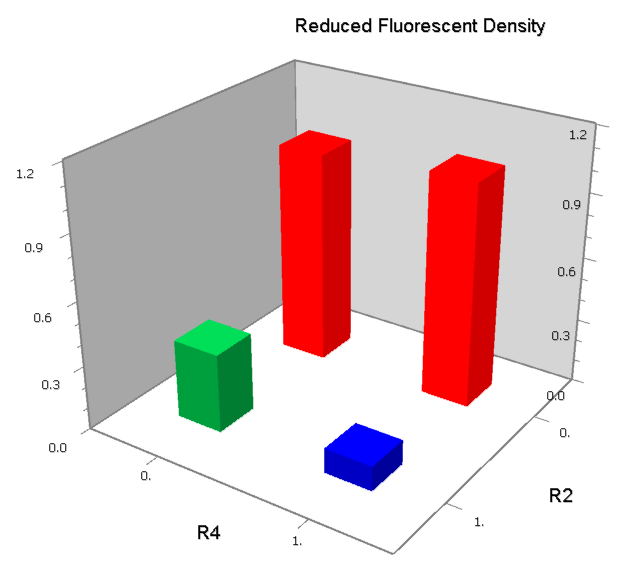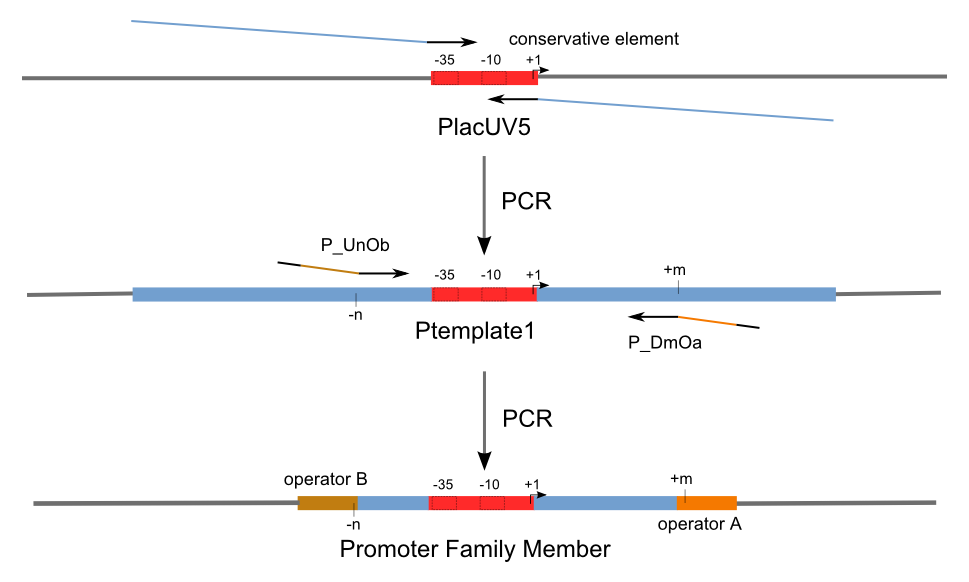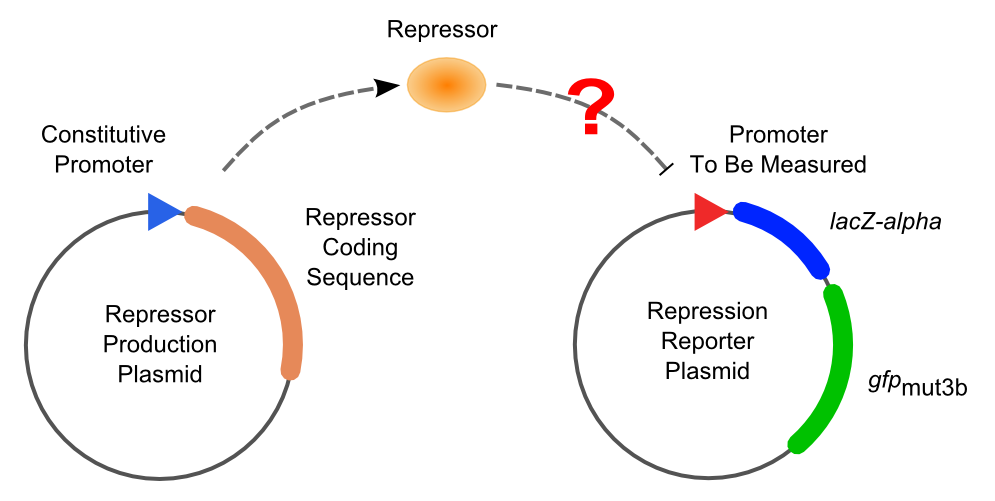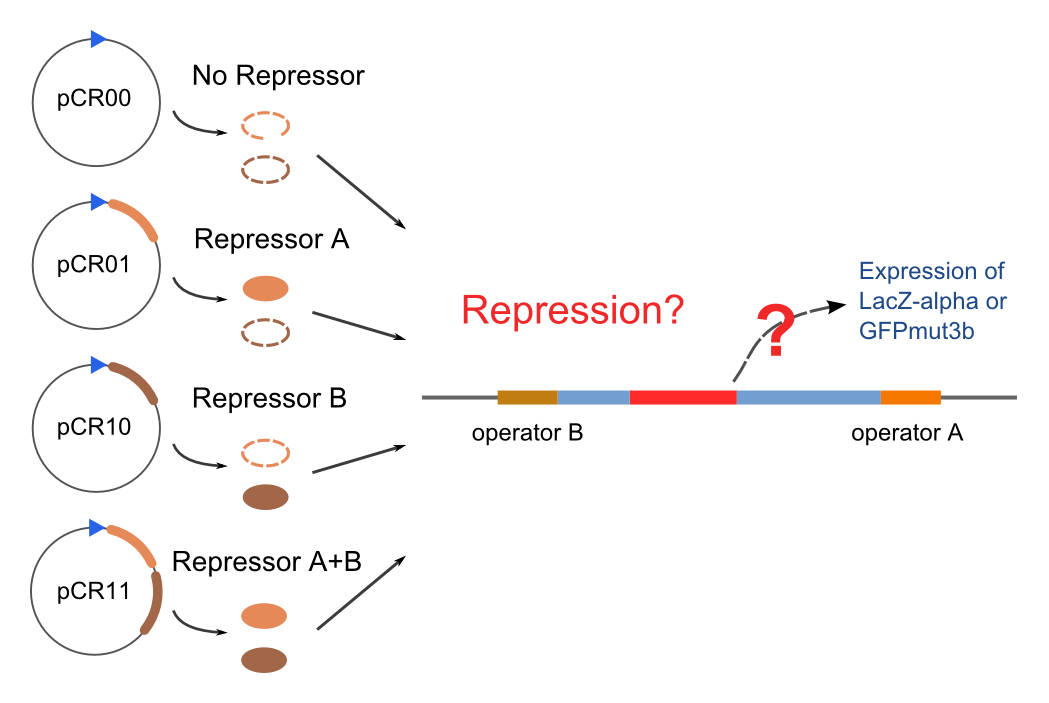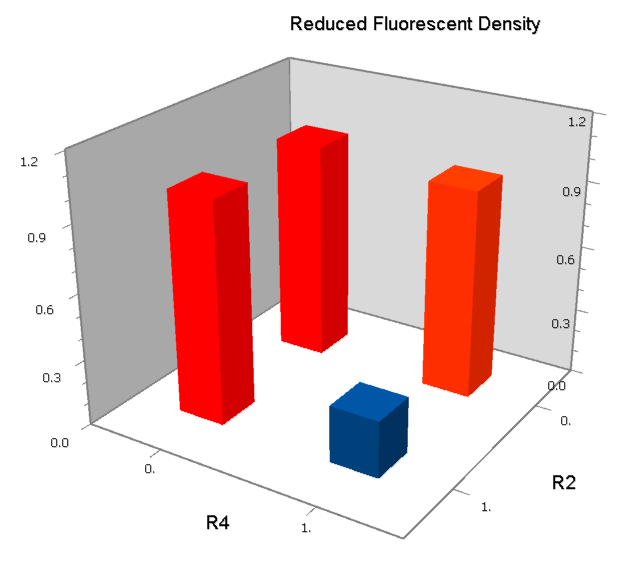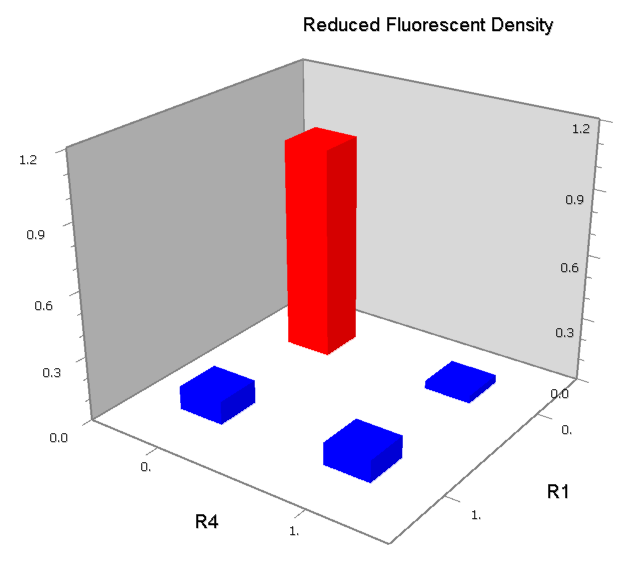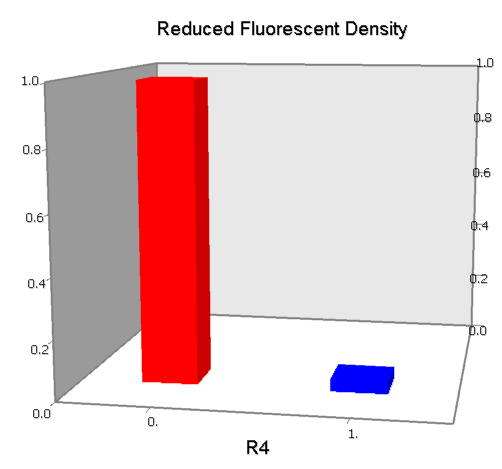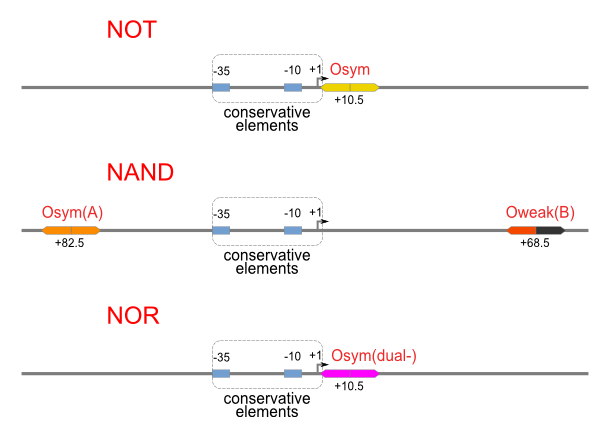USTC/Logic-Gate Promoters
From 2007.igem.org
Contents |
Cis-acting Bio-Logic Gates
In natural cells, combinational logic computation can be carried out by cis-acting elements [4]. Theoretically, dual repressors interacting on two adjacent operators can generate complex logic function as NAND, NOT and NOT [1,2,3]. However, seldom of the parameters of these models has been measured, and practical artificial logic promoters are hard to make because of the lack of appropriate inputs. In this project, we simplify these models to reduce the number of parameters, use artificial high-specific repressors based-on Lac repressor [8] to serve as inputs, predict possible patterns of logic promoters, construct and test them experimentally, all to attempt to find a systematical way to construct cis-acting bio-logic promoters. As a result, a piece of DNA about 60 - 200bp is able to be built up and to act as a logic gate.
Advatanges of Cis-acting Bio-Logic Gates
- Work in vivo and can be genetically inherited
- Can be systematically built up according to several patterns
- Small in scale
- About 2.0nm in width, 20 - 70nm in length, similar to transistors in present VSLI in size [12], sometimes even smaller
- Can be cascaded to implement any complex combinational logic computation
- And is also able to form sequential circuit
Repression Model
Lacramioara Bintu et al. have reported a simple thermodynamic model which can quantify promoter activity under one or more regulatory factors [1,2]. In this project, we focus on the multiple changes of promoter activity under the existence of one or two repressors. For a weak promoter, the multiple of its change can be approximately described as a function of different repressor concentrations, inter-operator distances, repressor–operator affinity and repressor-repressor interactions.
For a promoter containing a single operator site shown in Figure 1(a), the promoter activity under R repressor molecules A(R) is:
Note that A(0) is the promoter activity without repression; ρ(P) is the solo-repression coefficient of the operator at the position P; Δε(O) is the difference of binding energy of operator O on specific sites to non-specific sites; NNS is the number of non-specific sites; and KB means the Boltzmann constant, T is the temperature.
For a promoter containing two different operators, of which the relative repressors may be able to interact with each other shown in Figure 1(b), the promoter activity under combinations of two repressors, RA and RB, is given as:
Where ω(PA, PB) is the co-repression coefficient when OA is located at PA, and OB at PB.
Concerning a NOT gate which works under approximately equal high or low repressor concentration, Rlow=0 and Rhigh=RH, we assessed its performance by giving it a score:
In the same way, NAND score and NOR score are:
In the situation with a fixed combination of two repressors, RA and RB, and approximately equal high or low repressor concentration, the logic performance of a promoter is a function of inter-operator distances, repressor–operator affinity and repressor-repressor interactions. By adjusting these parameters, it is possible to find out well-performing bio-logic promoters.
Schemes of Bio-Logic Promoters
Dozens of potential bio-logic patterns were experimentally synthesized and tested in solo-repression or co-repression test-bench. Some representative ones are shown and commented as following.
Valuable Experiences for Bio-Logic Promoters
Factors of Gate-Performances
The level of repression in vivo is determined by several factors . Because both 'strong' operator and 'weak' operator are required for our system, we systematically tested the effects by the two primary factors: composition and position.The proper distance between two operators is also necessary for NOR and NAND gates, and data has been reported.
Hybrid Operator and Dual-Repressed Operator
Based on the data of operators' composition, two ideas have been proposed and attempted to realize:
- Crossbreeding two specific operators may be able to carry out new functions.
- A specific operator repressed by two or more different repressors can be used as a model for NOR gate.
Repression Assay
Build Up Promoter Family
Firstly, we extend both sides of the conservative region for transcriptional initiation [9] of PlacUV5 [7], including -35 box,-10 box and +1 starting point, with two non-sense sequence selected from random groups. The product is named as P_template1 as it is the template for the promoter family. These two non-sense sequence have three main characters:
- They will never include the restriction enzyme cutting sites that will be involved in the whole study;
- They will never include the recognition sites of RNA Polymerases and those of either of the two repressors;
- They will never present in complicated structures.
Secondly, another group of primers, of which the elongation region at 5’ end may contain a unique operator sequence or each, is applied at both ends of P_template1, equipping us with an according group of promoters with complete structures. These promoters can include variant operator sequences at different position in flank of the conservative region.
Then the promoter fragments are digested with XbaI and BamHI and loaded into repression-reporter plasmid, which contains lacZ alpha fragment and gfp under the promoter insertion site.
All the members of the our promoter family are named according to a uniform rule.
Solo-Repression Assay
Two plasmids are used in solo-repression assay. First, a plasmid constitutively expressing a specific repressor is transformed into Top10. Then the promoters to be tested, which contain variant operator compositions and positions, are transformed into the strains got in the first step and then selected through double resistance.
Co-Repression Assay
Promoters to be tested are loaded into double-reporter plasmid and then transformed into the four test strains (CR00, CR01, CR10, CR11). By reading the color of the colonies on plates with X-Gal, and by testing the fluorescence intensity under a fluorescence microscope, we can get the solo-repression and co-repression effects of the two repressors on specific promoters.
| Genotype | Character | Name |
| Top10/pT-TERM | So not express any repressors | CR00 |
| Top10/pT-ARL4A0604 | Constitutively express ARL4A0604 | CR01 |
| Top10/pT-ARL2A0203 | Constitutively express ARL2A0203 | CR10 |
| Top10/pTet-ARL4A0604-ARL2A203 | Constitutively express ARL4A0604 and ARL2A0203 | CR11 |
Final Results
Suggested Patterns
NAND
A NAND Gate requires that two solo-repressions should be weak, and co-repression should be strong. We choose +83.5 to put the upstream operator, to avoid the uncertain activator regions. Another weak operator is fixed at the +66.5 site. The relative distance between the two operators is 150, indicating a strong co-repression.
NOR
We expected to find a NOR gate with two different operators around the conservative region of a promoter. However, there is not any available repressor binding site in the upstream of the conservative region based on the observed effect of operator positions. At present only the dual-repressed pattern works well as NOR gate, but it brings us a limitation in wires selection when assembled into the whole system.
NOT
The NOT gate is quite simple, containing only one operator of reverse symmetric structure at the +10.5 site.
References
1. Bintu, L.; Buchler, N. E.; Garcia, H. G.; Gerland, U.; Hwa, T.; Kondev, J.; Kuhlman, T. & Phillips, R. (2005), 'Transcriptional regulation by the numbers: applications.', Curr Opin Genet Dev 15(2), 125--135.
2. Bintu, L.; Buchler, N. E.; Garcia, H. G.; Gerland, U.; Hwa, T.; Kondev, J. & Phillips, R. (2005), 'Transcriptional regulation by the numbers: models.', Curr Opin Genet Dev 15(2), 116--124.
3. Buchler, N. E.; Gerland, U. & Hwa, T. (2003), 'On schemes of combinatorial transcription logic.', PNAS 100(9), 5136--5141.
4. Davidson, E. H.; Rast, J. P.; Oliveri, P.; Ransick, A.; Calestani, C.; Yuh, C.; Minokawa, T.; Amore, G.; Hinman, V.; Arenas-Mena, C.; Otim, O.; Brown, C. T.; Livi, C. B.; Lee, P. Y.; Revilla, R.; Rust, A. G.; jun Pan, Z.; Schilstra, M. J.; Clarke, P. J. C.; Arnone, M. I.; Rowen, L.; Cameron, R. A.; McClay, D. R.; Hood, L. & Bolouri, H. (2002), A genomic regulatory network for development., Science 295(5560), 1669--1678.
5. Elledge, S. J. & Davis, R. W. (1989), 'Position and density effects on repression by stationary and mobile DNA-binding proteins.', Genes Dev 3(2), 185--197.
6. Kalodimos, C. G.; Bonvin, A. M. J. J.; Salinas, R. K.; Wechselberger, R.; Boelens, R. & Kaptein, R. (2002), 'Plasticity in protein-DNA recognition: lac repressor interacts with its natural operator 01 through alternative conformations of its DNA-binding domain.', EMBO J 21(12), 2866--2876.
7. Lanzer, M. & Bujard, H. (1988), 'Promoters largely determine the efficiency of repressor action.', PNAS 85(23), 8973--8977.
8. Lewis, M. (2005), 'The lac repressor.', C R Biol 328(6), 521--548.
9. Rojo, F. (1999), 'Repression of transcription initiation in bacteria.', J Bacteriol 181(10), 2987--2991.
10. Saiz, L. & Vilar, J. M. G. (2006), 'DNA looping: the consequences and its control.', Curr Opin Struct Biol 16(3), 344--350.
11. Sheridan, S. D.; Opel, M. L. & Hatfield, G. W. (2001), 'Activation and repression of transcription initiation by a distant DNA structural transition.', Mol Microbiol 40(3), 684--690.
12. [http://cnse.albany.edu/News/index.cfm?step=show_detail&NewsID=424 Semiconductor International: 45 to 32 nm: Another Evolutionary Transition.]
